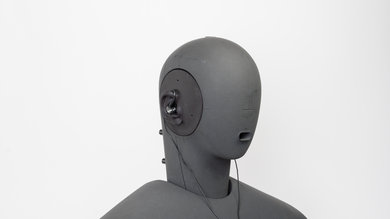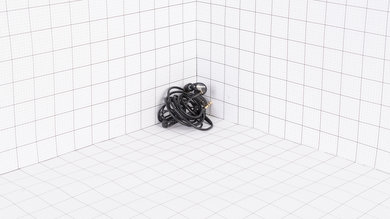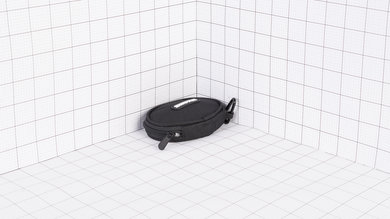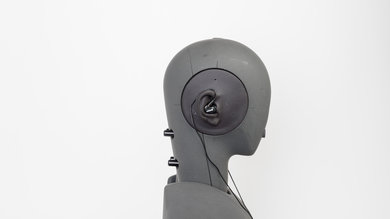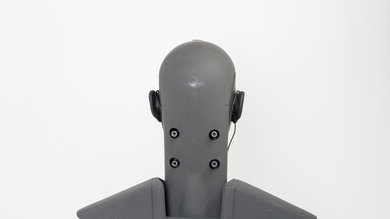Shure is a mainstay of professional audio products. They're known for their widely recognizable microphones, which have graced the stages of some of the most iconic concerts of all time, the garages of budding bands, and the studios of your favorite podcasts. Shure's headphone department is comparatively new but is backed by decades of experience. The Shure SE215 in-ear monitors (IEMs) are a no-nonsense, wired set of earphones. Their simple and well-conceived design prioritizes passive noise isolation, which uniquely positions them for monitoring on-stage audio or for enthusiasts who prefer warmer tunings during their listening sessions.
Our Verdict
The Shure SE215 are alright for neutral sound listening. They have a prominent bass and mid-range, making them sound a bit boomy and cluttered. Their treble range is also mostly recessed with a couple of sharp peaks. Like most in-ear designs, the small closed-back earbuds don't offer spacious and immersive soundstages. However, these are designed for monitoring audio, so the tuning makes sense for musicians on stage wanting to hear the rhythm sections and lead instruments with effective noise isolation. They have low distortion, so your audio sounds clean, and because they're in-ears, once you get a good fit, you'll have consistent audio delivery.
- Impressive noise isolation.
- Stable and portable design.
- No controls.
- Soundstage isn't spacious and immersive.
The Shure SE215 are passable for commuting and traveling. They block noise better than some active noise cancelling (ANC) headphones, have a compact design that will fit into your pockets, and feel comfortable for in-ears. Their build quality and case ensure they'll endure your commute. Unfortunately, they have no in-line remote or control scheme. Also, because they only block environmental noise through passive isolation, you can't switch to an ambient mode on the fly if someone starts talking to you, even if you don't need to worry about a battery.
- Impressive noise isolation.
- Stable and portable design.
- Minimal sound leakage.
- No controls.
- No microphone.
- No listening modes.
The Shure SE215 are acceptable for sports and fitness. They have a stabilizing over-ear cable coupled with a deep in-ear fit, so they don't move around much. The sound profile supplies a good amount of punch to motivate your workout. Their size is compact enough to carry on you, stowed in the zip case. While they lack an IP rating against water and dust, their build quality is robust. Unfortunately, they don't have a control scheme, which isn't ideal when working out or running.
- Durable build quality.
- Stable and portable design.
- No controls.
- Cable might get in the way while exercising.
The Shure SE215 are mediocre for office use. Despite a comfortable fit, they aren't ideal headphones to wear for your entire work shift due to their invasive in-ear fitting design. They lack controls and a mic for audio playback and online meetings. However, they barely leak your audio, so you won't bother your office mates. They also block a lot of passive noise, like communal kitchen and ambient noise. Plus, you don't have to monitor battery levels.
- Impressive noise isolation.
- Minimal sound leakage.
- No controls.
- No microphone.
The Shure SE215 are wired headphones; you can't use them for wireless gaming.
The Shure SE215 are not bad for gaming. Their elevated bass response helps you hear sounds like footsteps in games. They have a consistent frequency response delivery for predictable sound between wears. Their isolation performance also helps block out distractions. However, their sound profile de-emphasizes treble, which makes details less clear, and their poor soundstage isn't immersive and spacious. They have no mic or in-line controls, but you can connect them to your console's controller or PC for latency-free audio.
- Impressive noise isolation.
- Durable build quality.
- Stable and portable design.
- No controls.
- No microphone.
- Soundstage isn't spacious and immersive.
The Shure SE 215 don't have a microphone, so you can't use them for phone calls without a separate mic.
Changelog
-
Updated Nov 18, 2025:
The Wired box has been updated to compare the CrinEar Daybreak.
- Updated Apr 12, 2024: This review's text was revisited with significant revisions throughout, aligning with our current standards and making it easier to compare to other reviews. No changes have been made to the scores.
- Updated Nov 01, 2021: Converted to Test Bench 1.5.
- Updated Feb 17, 2020: Converted to Test Bench 1.4.
Check Price
Differences Between Sizes And Variants
The Shure SE215 come in several semi-translucent colorways, and our unit is the 'Black' variant. They also come in 'Clear,' 'Blue,' 'Green,' and 'Purple.' Some colors have changed or been discontinued over the years, like a solid black variant that's no longer available. The Shure SE215 PRO are virtually the same product, and sometimes their packaging doesn't even say 'PRO.' The main difference is that the 'PRO' variant comes with either a 3.83 ft or 5.33 ft cable rather than the 5 ft cable on our unit.
In addition, the brand produces a model with an in-line microphone and control module, the Shure AONIC 215, which comes with a larger case. There's also the Shure SE215 True Wireless Earphone Bundle Gen 2, which includes the same earbuds, adapters for Bluetooth audio, and a cable for wired listening.
The manufacturer offers a host of similar models that use the same basic earbud design and drivers. We expect these to perform similarly to our unit as they have the same '215' product codes and drivers, but we can't test for some features, like controls and microphone performance, that aren't on our standard SE215 unit.
If you encounter another variant of these headphones, let us know in the forums, and we'll update our review.
Popular Headphones Comparisons
The Shure SE215 are a straightforward wired-only design at the second lowest tier of the brand's IEM line-up. Their deep in-ear fit is fairly low profile and stable with over-ear cabling. They uniquely block more of your environmental surroundings than most headphones without active noise cancelling (ANC). However, their sound profile favors a more bass and mid-range forward sound, so if you want something with a more balanced sound, there are other options like the high-end MOONDROP Blessing 3. If you like the extra boominess but still want a more excited treble response, the TRUTHEAR x Crinacle ZERO are worth a look. The downsides of both are that they use more delicate two-pin connectors to the earbuds and don't block nearly as much environmental noise as the Shure.
See our recommendations for the best wired headphones, the best in-ear headphones, and the best headphones for music.
The Sennheiser IE 200 have a similar sound to the Shure SE215. While the Sennheiser have a warm sound, their treble range isn't quite as recessed as the Shure. Both buds are comfortable and have solid passive noise isolation performances, though the Shure are slightly better built. Both are viable choices for on-stage monitoring or as entry-level IEMs, and choosing between them could come down to small details and personal preference. Some might prefer the Sennheisers' foam tips over the Shures' silicone ones, for example.
The Shure SE215 and the Shure SE425 are very similar in design, but they have completely different sound profiles. The SE425 lack bass and over-emphasize frequencies in the mid and treble ranges, making them sound rather boxy and harsh. The SE215 sound significantly better-balanced in the mid-range but they lack detail and brightness, so they have a darker overall sound profile.
The KZ ZS10 sound brighter with a slightly more balanced bass range than the Shure SE215 in-ears. The KZ have a slightly more premium-looking design. The Shure, on the other hand, have a slightly more comfortable fit and better noise isolation than the KZ. Their overall sound is warmer. However, while both headphones are well-built in-ears with no in-line remotes, the sound of the KZ makes them more versatile.
The KZ AS10 are better-sounding headphones than the Shure SE215. They also look better and have a better build quality, thanks to the braided and replaceable cable. You can also find a variant of the KZ in an in-line remote and mic, which the Shure lacks. However, the Shure are more comfortable and offer slightly better noise isolation. The better sound quality and cheaper price make the KZ a better choice over the Shure.
Test Results

The Shure SE215 are made of semi-translucent plastic housings that come in a variety of colors. The wired IEMs fit with the flexible and detachable cable over your ears. They're reasonably discreet unless you choose a bright color from the options of 'Black,' 'Clear,' 'Green,' 'Blue,' and 'Purple.' This housing shape is very similar to other models by the manufacturer, like the Shure SE425. Similarly, the brand has reworked the same drivers and housings for the Shure SE215 PRO model, which is virtually the same as the standard version, and the true wireless version, the Shure AONIC 215 Gen 2.
These IEMs have a comfortable in-ear fit. They include a total of six ear tip sizes to help you find the right fit in both silicone and memory foam. Their angled design helps to ensure a better fit for the contours of your ears. The invasive fit of IEMs can feel comfortable with the right ear tips, but it's also fatiguing after a long session. Their plastic housing is pretty lightweight, so they're not as heavy as the MOONDROP KATO, which have stainless steel buds.
These don't come with any controls. However, the brand also makes a set with the same housings and drivers, the Shure AONIC 215, which includes a cable with in-line controls.
These headphones come with a good soft canvas case instead of the hardshell one that comes with the Shure SE425. It's portable and protects the headphones from impacts and drops but will not shield them from water damage besides a couple of raindrops. It also adds a bit of bulk, but since it's a soft case, you can squeeze it into tight spaces.
The Shure SE215 have very good build quality. Their plastic feels dense and sturdy. They have a thick and durable cable. The cable is also removable with sturdy MMCX connectors, which used to be relatively rare for in-ears that weren't flagships, but it's increasingly common. This extends the life of the earphones since you can always buy a replacement if the cable gets damaged by regular wear and tear. Unfortunately, no extra cables are provided in the box, which is somewhat disappointing. You can also check out the TIN Audio T3 or KZ AS10 if you want equally well-built in-ears with a slightly more unique look.
These in-ear headphones have good stability. The wired in-ear fit goes fairly deep into your ear canal. If you choose the memory foam ear tips, they expand to hold the earbuds in place. Their cable is flexible and fits over the top of your ear—it's not stiff like the KZ ZSN. This makes them stable enough for sports and working out since they will rarely fall out of your ears unless you physically pull them out or the audio cable gets hooked on something.
Their sound profile is warm, with emphasized high bass and mids. They reproduce music with a prominent boom and attack on bass guitars and kick drums. Their mid-range can sound cluttered and muddy with complicated mixes containing a lot of rhythm guitars, keys, and lead guitars. However, as these are designed for monitoring audio, those are the important frequencies to hear in live circumstances. Through the high mids, they provide a more balanced sound for present vocals.
The mostly under-emphasized treble range results in darker vocals and cymbals without much harmonic detail. A peak in the low treble adds focus to sibilant sounds like S and T for clarity, although it's somewhat uneven sounding. The de-emphasized treble can help avoid premature fatigue when monitoring audio.
The frequency response consistency is outstanding. Using one of the six pairs of ear tips will help you find a proper fit. Delivery of bass through treble is very consistent between wears and wearers for a predictable sound each time.
The Shure SE215 bass accuracy is great. While they lack a thumpy low bass, the mid-bass adds a touch of extra body to bass guitars and punch to kick drums. However, the high-bass, which is responsible for warmth, is overemphasized, making the bass boomy and muddy with busy mixes. If you're looking for IEMs with a more even and neutral bass range, check out the 7HZ Timeless.
The Shure SE215's mid-range is great. The bump in the low-mid continues on from the exaggerated high-bass, making the overall mix sound cluttered where lead instruments and bass meet. However, the rest of the mids are more balanced, leading to present vocals and clear lead instruments in the higher mids.
Their treble performance is mediocre. The overall response is uneven throughout the range. The low treble is gently recessed, producing somewhat clear vocal harmonics. A narrow peak in the low-treble affects sibilant sounds (like S and T) and the attack on cymbals, making them sound relatively harsh. Most of the mid-treble strongly rolls off, dulling harmonics and details.
Overall, this is a warm treble response, especially with the emphasis on the high-bass and mids. The one advantage of this tuning is that for live situations, your ears don't tire quickly from bright frequencies, although it can lead to over-compensating by turning up treble on outboard equalizers.
Their peaks and dips performance is decent. A wide peak in the bass through low mids makes bass instruments sound punchy but can muddy the mix. A slight dip in the mids relieves a bit of muddiness by pushing the lead instruments down in the mix a bit. A peak in the high mids brings a focus to vocal presence. The dip in the low treble evens out the harmonics from getting piercing. A narrow peak in the low treble adds harsh clarity to cymbal hits and sibilant harmonics (like S and T). Following the sharp peak, most of the mid-treble dips dramatically for a dark and warm top-end.
Their imaging performance is superb. The group delay is extremely even, and the phase response is below the audibility threshold. This ensures a tight bass and a transparent treble reproduction. Additionally, the L/R drivers of our unit are very well-matched, which is important for the accurate placement and localization of objects (instruments, voice, footsteps) in the stereo image. This performance aligns with other products we've tested by Shure, indicating fantastic ergonomics and quality control. Imaging varies between units, so these results are only valid for our unit.
The soundstage on these headphones is bad. This is normal for in-ear fitting and closed-back designs because they don't interact with your environment's acoustics or your outer ears. As a result, your audio sounds like it's coming from inside your head rather than spaciously spread outside and in the room.
These have very good weighted harmonic distortion performance. There's virtually no distortion in the bass and most of the mid-range. There's some distortion present in the treble with a peak corresponding with the frequency response's peak in the low-treble to mid-treble transition and in the uppermost registers at the thresholds of human hearing, although it's low overall. By and large, your audio sounds clean and pure, representative of the source audio.
These are the settings used for testing, and our results are only valid with these settings.
The isolation performance of the Shure SE215 is impressive. Although these in-ears don't have an active noise cancelling (ANC) system, they provide an impressive amount of passive-only noise isolation. Unusually for passive-only headphones, they block bassy noises well, like the rumble of airplane and bus engines. They suppress ambient noise like chatter and traffic well while isolating piercing and sharp noises like the shrieking brakes of a subway or crash cymbals (if you use these in a live music context). However, a narrow band of boomy noises will still reach your ears.
Their leakage performance is fantastic. Due to their deep in-ear fit, memory foam ear tips, and closed-back design, they barely leak sound. What escapes is audible as trebly and thin, mostly bright cymbals. The volume is quieter than most offices, so you won't bother your neighbors. Even if you listen at high volumes, the leakage is hard to hear. It's also unlikely a microphone will pick up a notable amount of leaked audio if you're tracking audio while wearing these IEMs.
The Shure SE215 don't have a microphone. However, the Shure AONIC 215 variant uses the same earbuds with a different cable that comes with an in-line microphone.
These are passive and wired-only. You can buy an adapter kit to make them truly wireless with Bluetooth capabilities by swapping out the detachable cable. The manufacturer also makes a variant, the SE215 True Wireless Earphone Bundle Gen 2, which includes Bluetooth adapters alongside a cable for wired listening.
The Shure SE215 use a 1/8" TRS audio cable with no in-line remote or mic. It connects to each earbud's housing via MMCX connectors. Our unit's cable is 5 ft (1.52m), but the otherwise identical Shure SE215 PRO's cable runs either 3.83 ft (1.17m) or 5.33 ft (1.63m). If you're looking for a balanced 4.4 mm jack as an option, the CrinEar Daybreak is worth considering, but it's not necessarily designed for professional applications like the Shure.
You can connect these headphones via analog for full audio support, but they don't have a microphone. You'll need an outboard microphone to participate in online meetings.
You can connect these headphones to your PlayStation's controller via analog for audio playback, although they don't have a microphone, so you can't chat with friends. The Shure AONIC 215 are virtually the same earbuds but with a different cable that includes a mic.
You can connect these earbuds to your Xbox controller's output for audio support. However, they don't have a mic, so you can't chat with friends. The Shure AONIC 215 are the same earbuds with a different cable and include an in-line microphone.

